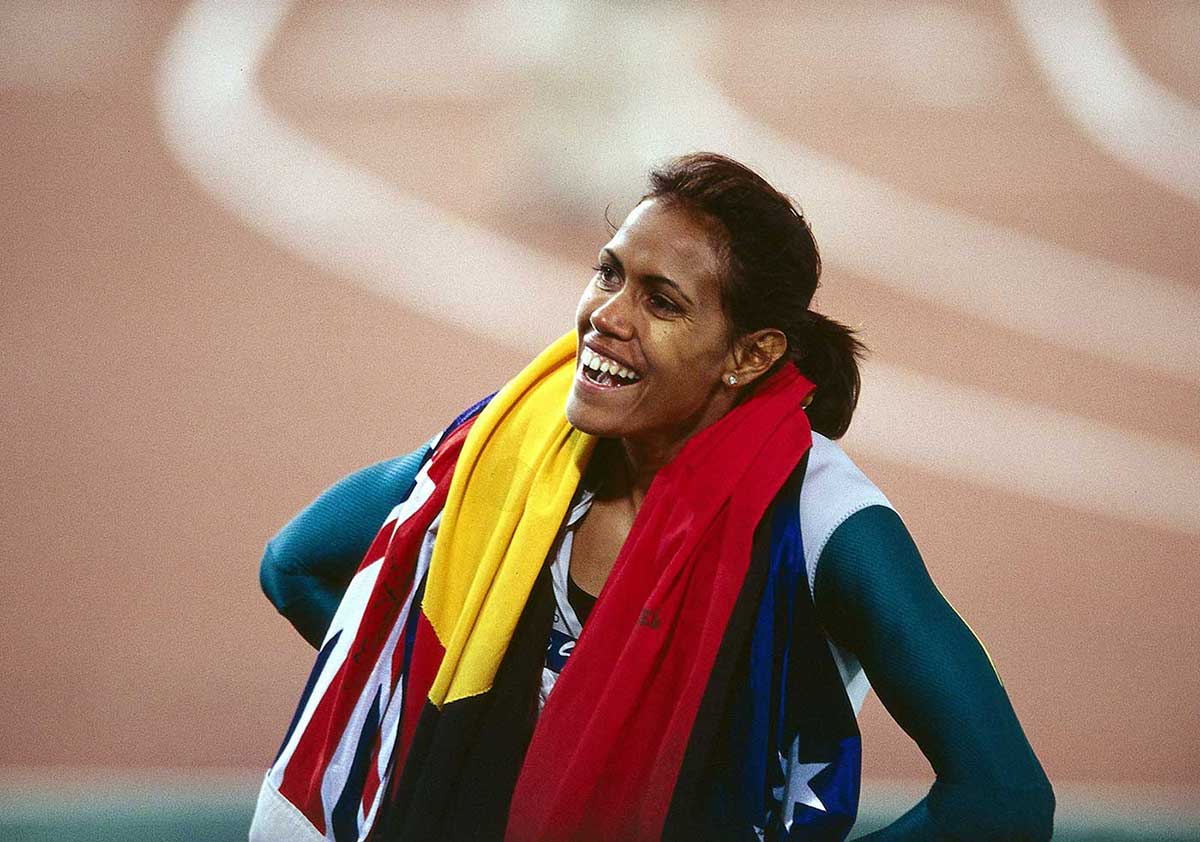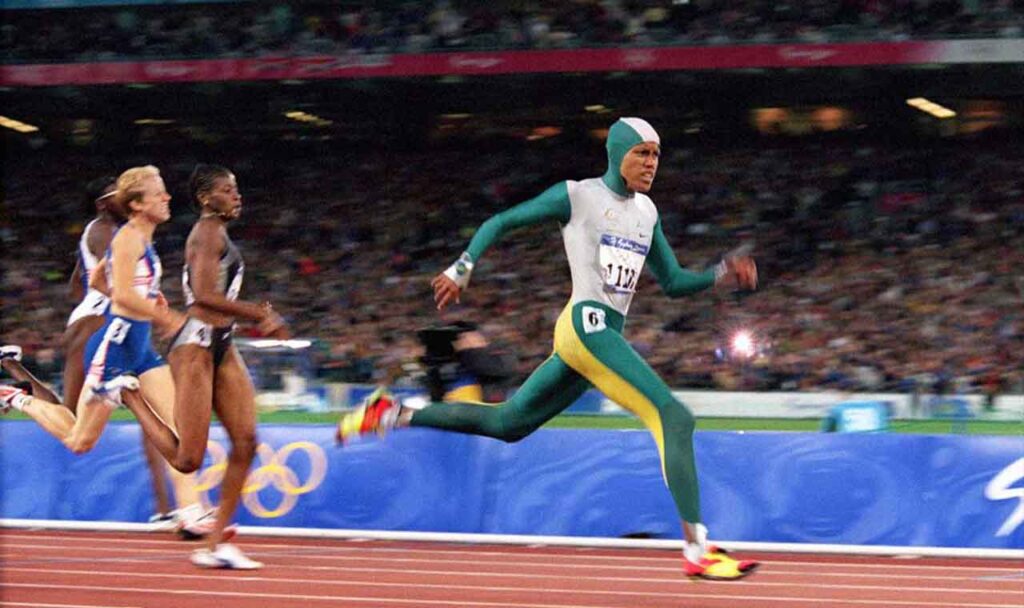At the 2000 Sydney Summer Olympics, all eyes were on Australian sprinter Cathy Freeman attempting to win gold in the 400m race. Stopwatches timed her every step en route to an iconic come-from-behind victory, uniting a nation in celebration.
This is the story of the race Freeman called her proudest sporting achievement and the stopwatches used to capture Australia’s unforgettable race to gold at the home Olympics

Australia’s Golden Girl
Cathy Freeman entered the 2000 Olympics with the hopes of a country upon her. She was Australia’s most prominent Aboriginal track athlete and a national icon.
The burden of expectations on the 22-year-old was immense, but her indomitable spirit and determination were up to the challenge. Freeman embraced the opportunity to inspire Aboriginal youth and unite all Australians.
Leading up to Sydney, Freeman won back-to-back world championships in the 400m in 1997 and 1999 confirming her gold medal potential. She was dubbed Australia’s best chance for Olympic track and field glory on home soil.
But Freeman would face fierce competition in Sydney from reigning Olympic 400m champion Marie-José Pérec of France and talented Jamaicans Lorraine Graham and Sandie Richards. Peaking at the perfect moment would be critical.
For Freeman though, the Olympics were about more than just winning. They were a chance to make a statement and create hope.
As she said, “It was always a dream of mine to light the Olympic flame and not just because I’m an athlete. I believe I am an Australian and I believe I am Aboriginal.”
Cathy Freeman
Gearing Up in the Call Room
On the evening of September 25, 2000, Cathy Freeman walked into the Olympic Stadium call room to make final preparations before the race. The cavernous arena was packed to the brim with 112,000 expectant fans sensing they may witness history.
As cameras broadcast her every move to the world, Freeman went through her meticulous pre-race routine – sips of water, stretching, meditation, blessing herself, and donning racing gear. The PR pressure could not disrupt her mental flow.
Finally, the call came for athletes to proceed to the track. Freeman walked out alone, unfazed by the mass spectacle awaiting. She was ready. Years of training had led to this moment under the Olympic lights.
The Race Begins
At the start line, Freeman ignited the crowd by proudly carrying both Australian and Aboriginal flags on her victory lap. This was her chance to make a statement beyond just the record books.
The eight competitors stepped to the line and took their marks. A single pistol shot pierced the electric air signaling the start of the race. They exploded from the blocks off the 100m straightaway and Freeman took the early lead heading into the first turn.
But coming off the bend, Lorraine Graham surged ahead just in front of Freeman. Sandie Richards and FORMER Olympic champion also moved up, applying pressure. They hit the 200m halfway mark with Freeman sitting in an uncharacteristic third place, boxed in by her rivals.
Time for a Comeback
Coming out of the turn after 250m, Freeman made her move launching her trademark late kick. She swung wide and stormed past Richards and Graham down the backstretch. As Freeman accelerated, a deafening roar came over the stadium. Fans jumped and shouted seeing their star seize the lead.
Heading into the final turn, Freeman continued pulling away from the field. Richards and Graham had no response. It was now a victory lap for Australia’s golden girl. Freeman crossed the line in a triumphant first place at 50.2 seconds. The mental burden was lifted as she collapsed in joy to the ground.

Across Australia, wild celebrations broke out. In her signature bare-shouldered bodysuit, Freeman had delivered the glorious Olympic moment a nation waited for. Though other competitors’ stopwatch times came close, Freeman came out on top when it mattered most.
Stopwatches Capture the Epic Race
Of course, the most important timing came from the official Olympics stopwatches that documented Freeman’s and each racer’s official time.
Hand-held Seiko and Omega stopwatches with 100th-of-a-second accuracy operated by professional timekeepers lined the track. Their collective time of 50.22 was the mark entered into the final records. Multiple times ensured redundancy.
Beyond hand stopwatches, the Olympics rely on advanced electronic timing systems with camera and sensors. But stopwatches remain a crucial backup, especially for close races that come down to 1/10th of a second like Freeman’s epic comeback. Stopwatch timers also verify computer systems are working accurately.
The timekeepers’ ability to start and stop the stopwatches on the gun, follow athletes around the curve, and monitor the displays takes years of practice to perfect. Their split-second precision ensured every competitor’s time was fairly registered.
Cathy Freeman’s victorious 50.22 gold medal time was stamped into history books thanks to diligent timekeepers and reliable stopwatches that never waivered under the Olympic spotlight.
The Lasting Impact of Freeman’s Run for Unity
Cathy Freeman’s come-from-behind 400m gold medal run at the Sydney 2000 Olympics represented far more than a personal win. She emerged as an icon of Aboriginal pride and hope as the first Aboriginal Olympic gold medalist.
By carrying the Aboriginal flag on her victory lap, Freeman powerfully symbolized Australia’s opportunity for reconciliation. As she circled the stadium, Australians of all backgrounds came together in a rare transcendent moment of unity.
Nearly half the country tuned in to watch Freeman’s race, celebrating not just her athletic brilliance but her embodiment of human perseverance. She ignited belief in overcoming divisions. Beyond the record-setting 50.22 time, Freeman’s run inspired Australians to run together towards a better future.
